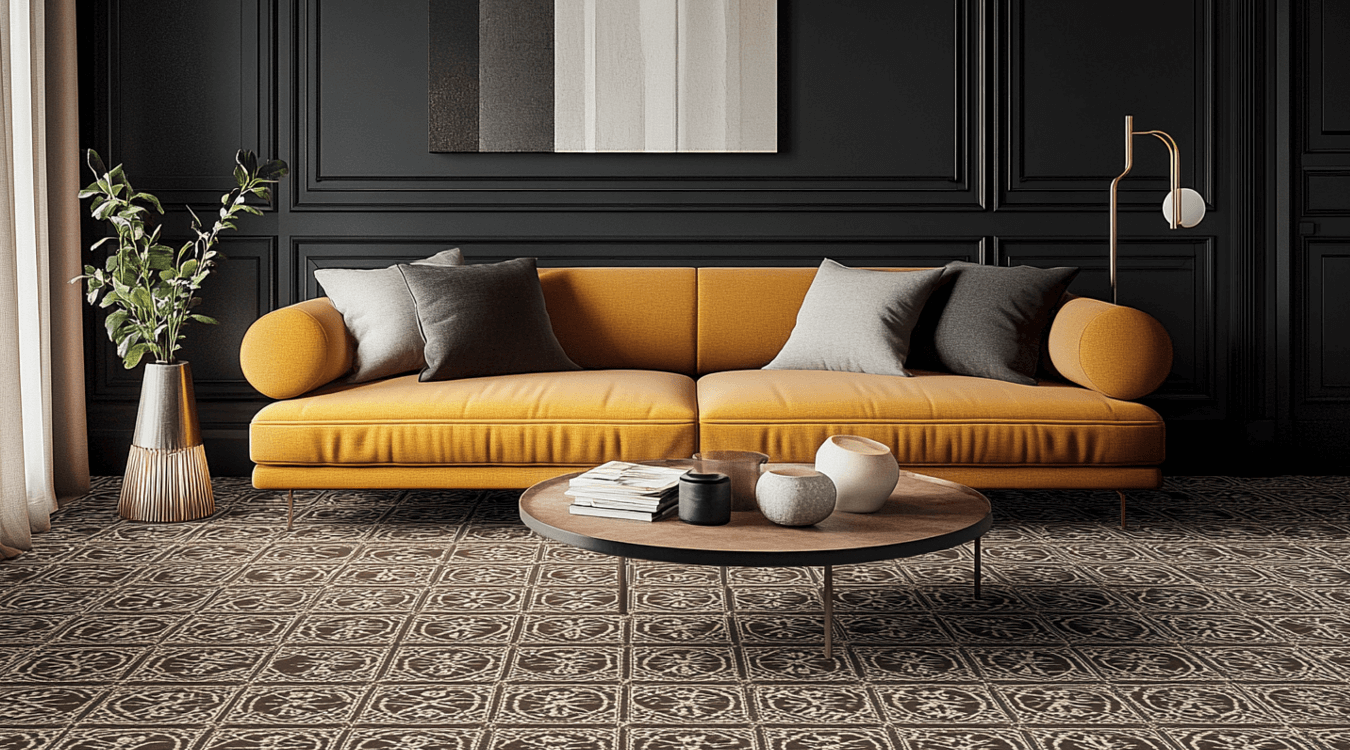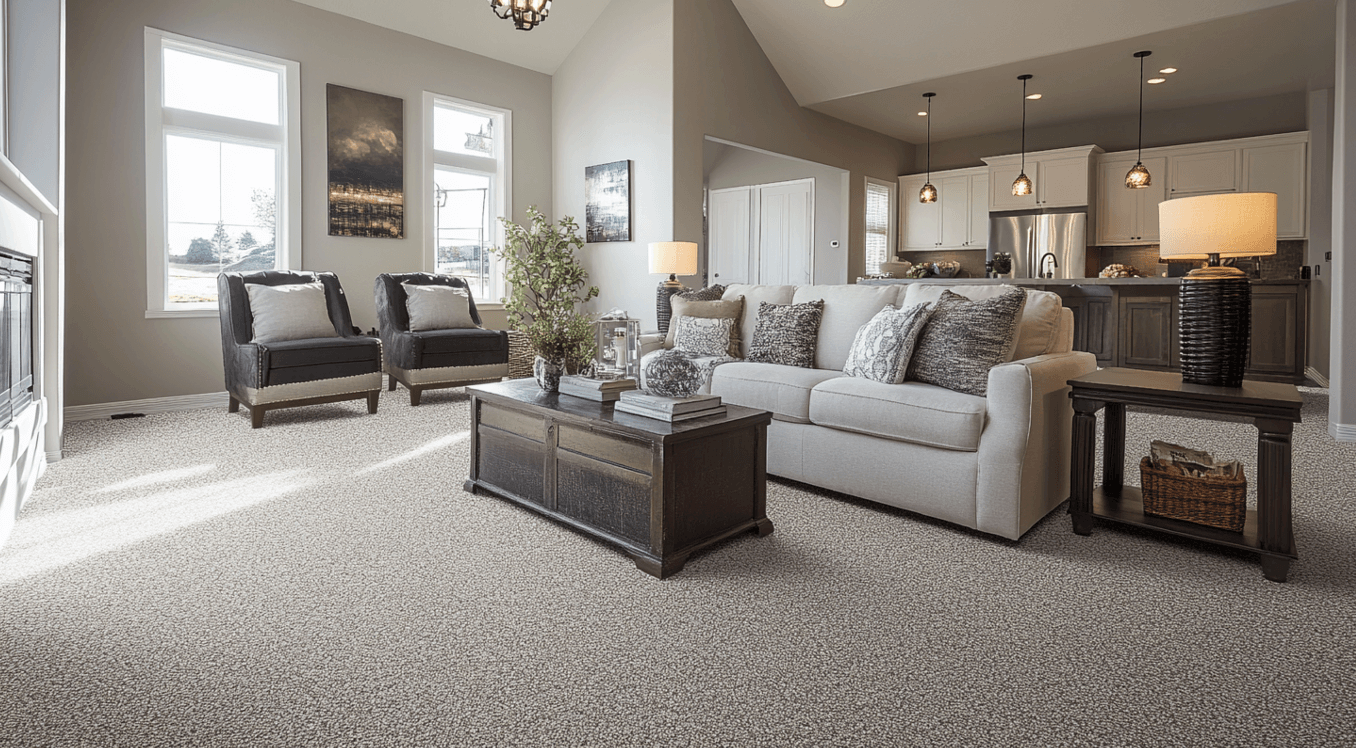There's nothing worse than stepping onto an ice-cold floor on a winter morning – it's not just uncomfortable, it can make your entire home feel unwelcoming and chilly no matter how high you set your thermostat.
Enter underfloor heating, the unsung hero in the battle against cold feet.
Underfloor heating can make a drastic difference to both comfort and energy bills - while traditional radiators need to run at 65-75°C to heat a room effectively, underfloor heating only needs to operate at 29-35°C to achieve the same comfort level, which results in energy savings of 15-40% on your heating bills.
With these benefits in mind, you might be wondering: what flooring is best for underfloor heating?
While most modern options are compatible, certain flooring choices truly stand out when it comes to heat conductivity and energy efficiency.
Let’s take a look at the best flooring for underfloor heating:
4. Carpet
Artesia in Midnight Carpet Flooring
We’re aware carpet might not be the first flooring type that comes to mind for this application, but there are specific varieties that work surprisingly well with these systems.
In fact, modern carpet technology has made it entirely possible to combine the cozyness of this flooring material with the efficiency of underfloor heating - as long as you choose the right specifications.
The key lies in selecting carpeting with a lower tog rating and appropriate underlay designed for heated floors.
This tog rating is crucial - it measures thermal resistance and indicates how well the carpet insulates against heat loss, where lower ratings allow better heat transfer from your underfloor heating system up through to your room, making the difference between an efficiently heated space and one that's working harder than it needs to.
Tips:
- Choose carpets with a maximum combined tog rating of 2.5 (including underlay)
- Look for short pile carpets rather than thick, luxurious piles
- Select synthetic fibers like nylon or polyester over wool for better heat transfer
- Consider carpet tiles as an alternative to traditional broadloom carpet
- Avoid rubber-backed carpets as they can act as insulators
3. Engineered Hardwood
Driftwood Home in Idyllic Escape
While the timeless appeal of wood flooring makes it a popular choice for many homeowners, traditional solid wood isn't necessarily the best match for underfloor heating.
The problem lies in how solid wood reacts to temperature changes - it expands when heated and contracts when cooled, which over time leads to warping and cracking.
Engineered hardwood, however, excels in this department while looking virtually identical to solid hardwood.
Its innovative construction features a real hardwood veneer bonded to multiple layers of plywood or high-density fiberboard, creating a stable structure that can handle temperature fluctuations without compromising its integrity.
While it may take slightly longer to heat up than materials like tile, engineered hardwood maintains a comfortable surface temperature of around 25-27°C - warm enough to feel good underfoot without affecting the floor's structural stability.
Just keep in mind that bathrooms and other high-moisture areas aren't ideal for engineered wood, as prolonged exposure to water can still affect its performance.
Tips:
- Total thickness should ideally be no more than 15mm for optimal heat transfer
- The top layer (wear layer) should be no thicker than 4-6mm
- Look for woods with lower thermal resistance like oak, ash, or maple
- Avoid extremely dense exotic hardwoods as they can inhibit heat transfer
- Choose boards with a moisture content of 8% or less
- Wider planks may be more prone to movement, so consider narrower boards
2. Luxury Vinyl Plank (LVP)
Modern luxury vinyl plank flooring has revolutionized the market with its remarkable versatility and heating system compatibility.
What makes LVP particularly efficient with underfloor heating is its thin profile - typically ranging from just 4-8mm including its wear layer, it allows heat to transfer quickly and efficiently from your heating system to your room.
These wear layers do more than just distribute heat evenly across the surface – they also help protect your floor from daily wear and tear, which makes LVP an excellent choice for high-traffic areas such as living rooms.
Tips:
- Look for products with a maximum thickness of 8mm
- Choose options with rigid core construction for better stability
- Select products with an integrated underlay to minimize heat resistance
- Check the manufacturer's maximum temperature rating (usually around 27°C/80°F)
- Ensure the product has specific approval for underfloor heating use
1. Tile
At #1 on our list – and rightfully so – is tile.
There are several reasons why tile is the best floor for underfloor heating, but its exceptional heat conductivity is the biggest differentiating factor.
Porcelain and ceramic tiles are particularly excellent conductors of heat, with thermal conductivity ratings that far exceed other flooring materials.
For water-based (hydronic) underfloor heating systems, tile's superior conductivity means your system can run at much lower temperatures while still keeping your room perfectly warm.
Where other flooring types might need your system to heat water to 45°C (113°F) to achieve a comfortable room temperature, tile flooring can give you the same warmth with water temperatures as low as 35°C (95°F) - translating directly to lower energy costs and more efficient heating.
Natural stone tiles like slate, marble, and limestone also work exceptionally well with underfloor heating; however, it's important to note that these materials have varying heat conductivity rates (slate, for instance, offers excellent heat transfer, while marble might take slightly longer to warm up but retains heat beautifully)
Tips:
Choose thinner tiles (around 10mm) for better heat conductivity
Look for tiles specifically rated for underfloor heating systems
Select unglazed tiles for better heat transfer
Consider larger format tiles to minimize grout lines which can reduce heat transfer
Ensure proper adhesive and grout suitable for heated floors
Use flexible adhesive to accommodate thermal movement
Closing Thoughts
While all of these options can work well in their own right, choosing the right flooring for underfloor heating requires careful consideration. Factors like room usage, maintenance requirements, and desired heat efficiency should all play a role in your decision.
High-traffic areas like hallways and kitchens might benefit from the durability of tile or LVP, while bedrooms could be better suited to the comfort of carpet or the natural charm of engineered wood.
Your heating efficiency goals play a crucial role too. If maximum energy efficiency is your priority, tile's superior heat conductivity makes it the clear winner.
However, if you're willing to compromise slightly on heating efficiency for the look of natural wood or the comfort of carpet, modern manufacturing techniques have made these viable options too.
Just remember, working with professionals who understand the specific requirements of underfloor heating systems is crucial - they'll ensure proper preparation, appropriate underlays, and correct installation techniques.
Always check manufacturer warranties and installation guidelines, as improper installation can void warranties and compromise both your flooring and heating system performance.














